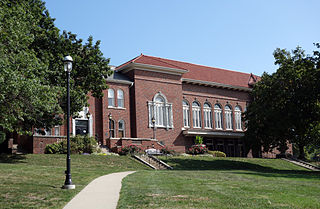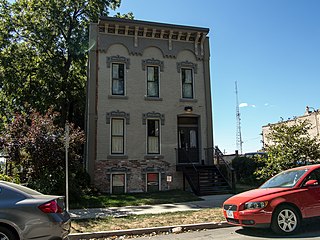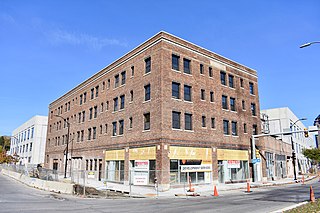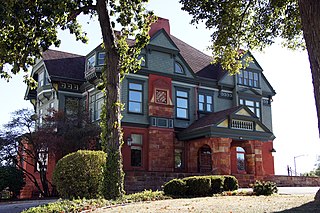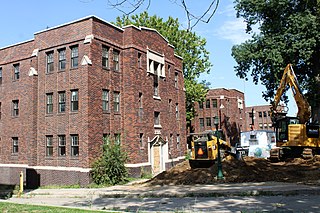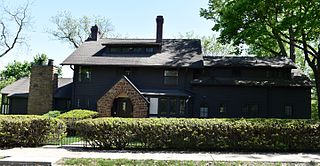Self-guided Sightseeing Tour #8 in Des Moines, United States
Legend
Tour Facts
3.7 km
0 m
Experience Des Moines in United States in a whole new way with our free self-guided sightseeing tour. This site not only offers you practical information and insider tips, but also a rich variety of activities and sights you shouldn't miss. Whether you love art and culture, want to explore historical sites or simply want to experience the vibrant atmosphere of a lively city - you'll find everything you need for your personal adventure here.
Individual Sights in Des MoinesSight 1: Hoyt Sherman Place
Hoyt Sherman Place, the home of Hoyt Sherman, was built in 1877 and is located in Des Moines, Iowa.
Sight 2: Henshie-Briggs Row House
The Henshie-Briggs Row House is a historic building located in Des Moines, Iowa, United States. While the row house was a popular building form in the 19th century in the city, there are very few examples that remain. The two-story, brick, Italianate structure was completed in 1883. The single-family dwelling features brick load-bearing walls, a flat roof, and a wooden cornice. The house was listed on the National Register of Historic Places in 2001. It was moved to its current location on Woodland Avenue in 2008.
Sight 3: The Argonne
The Argonne Building is a historic building located in Des Moines, Iowa, United States. It was built in 1919 and it was used as a showroom for the Ford automobile plant that was located across the street and for employee housing. In later years it served as a long-term hotel and as an apartment building for low-income renters. There are plans to convert most of the building into market-rate apartments and to maintain the commercial space on the main level. The building was listed on the National Register of Historic Places in 2020.
Sight 4: Herndon Hall
Herndon Hall, also known as the Bergmann Mansion, is an historical residential building located in Des Moines, Iowa, United States. The house was built in 1881 in the Queen Anne style. It was designed by the Des Moines architectural firm of Foster & Liebbe for attorney Jefferson Polk. He named the house after his wife, Julia Herndon. Over the years it has been the home of three bishops of the Diocese of Des Moines, a clothing store, and it served as the National Headquarters for Better Homes & Gardens Real Estate Service. It now houses a cosmetic & reconstructive surgery practice It was listed on the National Register of Historic Places in 1977.
Sight 5: Crawford House
The Crawford House is a historic building located in Des Moines, Iowa, United States. R.A. Crawford was a local banker who hired the Des Moines architectural firm of Liebbe, Nourse & Rasmussen to design this house, which was completed in 1896. It is located in a section of the city that contains other large residences that calls attention to the city's economic expansion. The 2½-story, brick structure is a combination of the Queen Anne and the Neoclassical styles. It features alternating colors of brick, limestone stringcourses, and two round towers with conical roofs that flank the main facade. The single-family home was converted into a funeral home in 1945. The house was listed on the National Register of Historic Places in 1983.
Wikipedia: Crawford House (Des Moines, Iowa) (EN), Heritage Website
Sight 6: Grand Trees Apartments
The Elmwood-The Oaks-The Birches, also known as the Grand Trees Apartments, are three historic buildings located in Des Moines, Iowa, United States. The local architectural firm of Vorse, Kraetsch & Kraetsch designed three-story brick structures that were built in 1923. The buildings, which together contain 93 units, are connected by courtyards and stone archways. Above the main entrances are imprints of the trees' leaves - elm, oak, and birch - in the stonework. Parking lots for the apartments are located behind the buildings. A $16.9 million historic renovation was begun in 2021 and will include adding elevators, which the buildings did not have. The buildings were listed on the National Register of Historic Places in 2021.
Sight 7: Jay Norwood and Genevieve Pendleton Darling House
The Jay Norwood and Genevieve Pendleton Darling House is a historic building located in Des Moines, Iowa, United States. The residence was the home of cartoonist Ding Darling, who worked for The Des Moines Register and whose cartoons were syndicated in over 100 newspapers across the country. In the early 1930s, he became involved in the conservation movement, especially wildlife conservation. His advocacy was reflected in his cartoons. Part of his conservation legacy in Iowa is the Cooperative Wildlife Research Unit program that he initiated at Iowa State College and the expansion of the research facilities at Iowa Lakeside Laboratory.
Wikipedia: Jay Norwood and Genevieve Pendleton Darling House (EN), Heritage Website
Sight 8: Albert Baird Cummins House
The Albert Baird Cummins House, also known as Terrace Tower, is a historic building located in Des Moines, Iowa, United States. This 21/2-story stone and stucco Queen Anne was built in 1893. It is significant because of its association with Albert Baird Cummins who lived here from the time it was built until 1920. A Republican, Cummins served as Governor of Iowa from 1902 to 1908 and as United States Senator from 1908 until his death in 1926. He was a Progressive who supported the "Iowa Idea," which sought to destroy trusts by removing tariffs from trust made products. As a senator he sponsored the Esch-Cummins Act that returned the railroads to private control after the government took them over during World War I. The house was listed on the National Register of Historic Places in 1982.
Wikipedia: Albert Baird Cummins House (EN), Heritage Website
Sight 9: Terrace Hill

Terrace Hill, also known as Hubbell Mansion, Benjamin F. Allen House or the Iowa Governor's Mansion, is the official residence of the governor of Iowa, United States. Located at 2300 Grand Avenue in Des Moines, it is an example of Second Empire architecture. The home measures 18,000 square feet (1,600 m2). It sits on a hill overlooking downtown Des Moines, and has a 90-foot (27 m) tower that offers a commanding view of the city. The building's steeply pitched mansard roof, open verandas, long and narrow and frequently paired windows, and bracketed eaves give this house an irreplaceable design. The house was designated a National Historic Landmark in 2003.
Sight 10: Mahnke House
The Mahnke House is an historical residential building located in Des Moines, Iowa, United States. The house was built by prolific Des Moines builder Fred W. Weitz in 1909 in the Prairie School style. The exterior is covered in Flemish bond brick veneer. It features a hip roof, a single-story west side solarium, a rear porch and a flat-roofed centered front portico with a raised entrance and square paned window lights. George and Emma Mahnke owned the house between 1909 and 1952 when they transferred the property to the Des Moines Annual Conference of the Methodist Church. The house then became the residence of the organization's superintendents. It was individually listed on the National Register of Historic Places in 1983, and it was included as a contributing property in the Ingersoll Place Plat Historic District in 2000.
Share
How likely are you to recommend us?
Disclaimer Please be aware of your surroundings and do not enter private property. We are not liable for any damages that occur during the tours.
GPX-Download For navigation apps and GPS devices you can download the tour as a GPX file.
